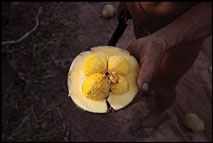Crossref Citations
This article has been cited by the following publications. This list is generated based on data provided by
Crossref.
Shock, Myrtle Pearl
and
Moraes, Claide de Paula
2019.
A floresta é o domus: a importância das evidências arqueobotânicas e arqueológicas das ocupações humanas amazônicas na transição Pleistoceno/Holoceno.
Boletim do Museu Paraense Emílio Goeldi. Ciências Humanas,
Vol. 14,
Issue. 2,
p.
263.
Costa, Luiz
and
Fausto, Carlos
2019.
The Enemy, the Unwilling Guest and the Jaguar Host.
L'Homme,
p.
195.
Witcher, Robert
2019.
Editorial.
Antiquity,
Vol. 93,
Issue. 368,
p.
287.
Capriles, José M.
Lombardo, Umberto
Maley, Blaine
Zuna, Carlos
Veit, Heinz
and
Kennett, Douglas J.
2019.
Persistent Early to Middle Holocene tropical foraging in southwestern Amazonia.
Science Advances,
Vol. 5,
Issue. 4,
Neves, Eduardo G.
and
Heckenberger, Michael J.
2019.
The Call of the Wild: Rethinking Food Production in Ancient Amazonia.
Annual Review of Anthropology,
Vol. 48,
Issue. 1,
p.
371.
Watling, Jennifer
Almeida, Fernando
Kater, Thiago
Zuse, Silvana
Shock, Myrtle Pearl
Mongeló, Guilherme
Bespalez, Eduardo
Santi, Juliana Rossato
and
Neves, Eduardo Góes
2020.
Arqueobotânica de ocupações ceramistas na Cachoeira do Teotônio.
Boletim do Museu Paraense Emílio Goeldi. Ciências Humanas,
Vol. 15,
Issue. 2,
Kater, Thiago
2020.
A temporalidade das ocupações ceramistas no sítio Teotônio.
Boletim do Museu Paraense Emílio Goeldi. Ciências Humanas,
Vol. 15,
Issue. 2,
Colonese, Andre Carlo
Winter, Rachel
Brandi, Rafael
Fossile, Thiago
Fernandes, Ricardo
Soncin, Silvia
McGrath, Krista
Von Tersch, Matthew
and
Bandeira, Arkley Marques
2020.
Stable isotope evidence for dietary diversification in the pre-Columbian Amazon.
Scientific Reports,
Vol. 10,
Issue. 1,
Iriarte, Jose
Elliott, Sarah
Maezumi, S. Yoshi
Alves, Daiana
Gonda, Regina
Robinson, Mark
Gregorio de Souza, Jonas
Watling, Jennifer
and
Handley, Josephine
2020.
The origins of Amazonian landscapes: Plant cultivation, domestication and the spread of food production in tropical South America.
Quaternary Science Reviews,
Vol. 248,
Issue. ,
p.
106582.
Gregorio de Souza, Jonas
Alcaina Mateos, Jonas
Madella, Marco
and
Biehl, Peter F.
2020.
Archaeological expansions in tropical South America during the late Holocene: Assessing the role of demic diffusion.
PLOS ONE,
Vol. 15,
Issue. 4,
p.
e0232367.
Mongeló, Guilherme
2020.
Ocupações humanas do Holoceno inicial e médio no sudoeste amazônico.
Boletim do Museu Paraense Emílio Goeldi. Ciências Humanas,
Vol. 15,
Issue. 2,
Strathern, Marilyn
2021.
Regeneração vegetativa: um ensaio sobre relações de gênero.
Mana,
Vol. 27,
Issue. 1,
Arroyo-Kalin, Manuel
and
Riris, Philip
2021.
Did pre-Columbian populations of the Amazonian biome reach carrying capacity during the Late Holocene?.
Philosophical Transactions of the Royal Society B: Biological Sciences,
Vol. 376,
Issue. 1816,
p.
20190715.
Mora, Santiago
2021.
Serpentear: énfasis y preguntas en el pasado amazónico.
Mundo Amazónico,
Vol. 12,
Issue. 2,
p.
171.
de Souza, Jonas Gregorio
and
Riris, Philip
2021.
Delayed demographic transition following the adoption of cultivated plants in the eastern La Plata Basin and Atlantic coast, South America.
Journal of Archaeological Science,
Vol. 125,
Issue. ,
p.
105293.
Cagnato, Clarissa
2021.
GATHERING AND SOWING ACROSS THE CENTRAL MAYA LOWLANDS: A REVIEW OF PLANT USE BY PRECERAMIC PEOPLES AND THE EARLY TO MIDDLE PRECLASSIC MAYA.
Ancient Mesoamerica,
Vol. 32,
Issue. 3,
p.
486.
Carney, Molly
Tushingham, Shannon
McLaughlin, Tara
and
d'Alpoim Guedes, Jade
2021.
Harvesting strategies as evidence for 4000 years of camas (
Camassia quamash
) management in the North American Columbia Plateau
.
Royal Society Open Science,
Vol. 8,
Issue. 4,
Pärssinen, Martti
Ferreira, Evandro
Virtanen, Pirjo Kristiina
and
Ranzi, Alceu
2021.
Domestication in Motion: Macrofossils of Pre-Colonial Brazilian Nuts, Palms and Other Amazonian Planted Tree Species Found in the Upper Purus.
Environmental Archaeology,
Vol. 26,
Issue. 3,
p.
309.
Bogaard, Amy
Allaby, Robin
Arbuckle, Benjamin S.
Bendrey, Robin
Crowley, Sarah
Cucchi, Thomas
Denham, Tim
Frantz, Laurent
Fuller, Dorian
Gilbert, Tom
Karlsson, Elinor
Manin, Aurélie
Marshall, Fiona
Mueller, Natalie
Peters, Joris
Stépanoff, Charles
Weide, Alexander
and
Larson, Greger
2021.
Reconsidering domestication from a process archaeology perspective.
World Archaeology,
Vol. 53,
Issue. 1,
p.
56.
Clement, Charles R.
Casas, Alejandro
Parra-Rondinel, Fabiola Alexandra
Levis, Carolina
Peroni, Nivaldo
Hanazaki, Natalia
Cortés-Zárraga, Laura
Rangel-Landa, Selene
Alves, Rubana Palhares
Ferreira, Maria Julia
Cassino, Mariana Franco
Coelho, Sara Deambrozi
Cruz-Soriano, Aldo
Pancorbo-Olivera, Marggiori
Blancas, José
Martínez-Ballesté, Andrea
Lemes, Gustavo
Lotero-Velásquez, Elisa
Bertin, Vinicius Mutti
and
Mazzochini, Guilherme Gerhardt
2021.
Disentangling Domestication from Food Production Systems in the Neotropics.
Quaternary,
Vol. 4,
Issue. 1,
p.
4.
